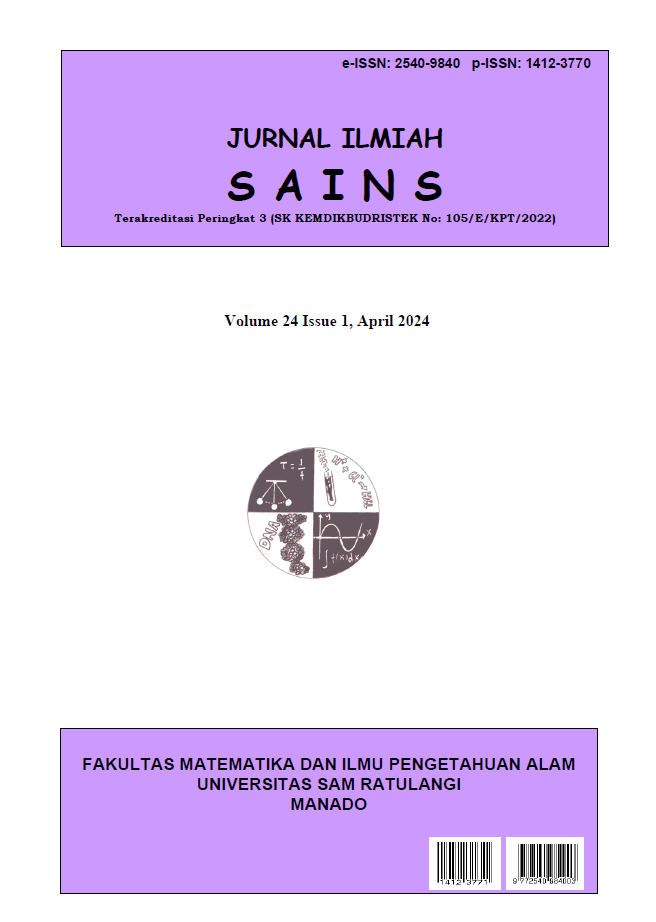Susceptible-Infected-Recovered Model of Mathematics Anxiety Behavior on Students' Mathematics Study Results at Aquino Catholic High School Amurang
DOI:
https://doi.org/10.35799/jis.v24i1.51387Keywords:
Amurang, mathematics anxiety, SIR modelAbstract
This study aims to see the spread of mathematics anxiety behavior on the results of students' mathematics studies at Aquino Catholic High School Amurang by using the SIR (Susceptible-Infected-Recovered) mathematical model. A total of 88 samples were collected and categorized into three groups based on predetermined criteria. These groups consisted of 47 students categorized as susceptible, 27 as infected, and 14 as recovered. The parameters in this study measure the rate of change within these three groups over a 365-day period, equivalent to one year. Two equilibrium points are obtained that can interpret populations free from math anxiety behavior or endemic math anxiety behavior. The stability analysis of the two equilibrium points shows that the equilibrium point free from math anxiety behavior is locally asymptotically stable. Additionally, this study also reveals that math anxiety behavior will disappear in less than 40 days through the basic reproduction number (Ro) obtained, which is 0.99 or less than 1.
Keywords: Amurang; mathematics anxiety; SIR model
References
Agus, A., Rahmawati, R., & Fardinah, F. (2020). Model Epidemi SIR Pengguna/Pemain Mobile Games Pada Mahasiswa Fakultas Matematika dan Ilmu Pengetahuan Alam Universitas Sulawesi Barat. Journal of Mathematics: Theory and Applications, 2(2), 46–53. https://doi.org/10.31605/jomta.v2i2.1185.
Artemenko, C., Daroczy, G., & Nuerk, H.C. (2015). Neural correlates of math anxiety–an overview and implications. Frontiers in Psychology, 6, 1333.
Blazer, C.A. (2011). Strategies for Reducing Math Anxiety. Information Capsule. Volume 1102. https://api.semanticscholar.org/CorpusID:142064752.
Chamnan, A., & Pongsumpun, P. (2021). Analyze of SEIR Dengue Infectious Transmission Model with Vaccination. Proceedings of the 7th International Conference on Bioinformatics Research and Applications, 1–5. https://doi.org/10.1145/ 3440067.3440068.
Luttenberger, S., Wimmer, S., & Paechter, M. (2018). Spotlight on math anxiety. In Psychology Research and Behavior Management (11). https://doi.org/10.2147/PRBM.S141421.
Lyons, I.M., & Beilock, S.L. (2012). Mathematics anxiety: separating the math from the anxiety. Cerebral Cortex, 22(9), 2102–2110. https://api.semanticscholar.org/ CorpusID:17621941.
Mangobi, J. U., Salajang, S. M., & Pitoy, C. (2023). SEIR Model of Dengue Hemorrhagic Fever with the Life Stage Structure of the Aedes albopictus Mosquito. Jurnal Ilmiah Sains, 23(2), 118–129. https://doi.org/10.35799/jis.v23i2.48235.
Marsh, J.K., & Shanks, L.L. (2014). Thinking you can catch mental illness: How beliefs about membership attainment and category structure influence interactions with mental health category members. Memory & Cognition, 42, 1011–1025.
Paechter, M., Macher, D., Martskvishvili, K., Wimmer, S., & Papousek, I. (2017). Mathematics anxiety and statistics anxiety. Shared but also unshared components and antagonistic contributions to performance in statistics. Frontiers in Psychology, 8, 1196.
Qausarina, H. (2016). Pengaruh kecemasan matematika (math anxiety) terhadap hasil belajar matematika siswa kelas X SMA Negeri 11 Banda Aceh. UIN Ar-Raniry Banda Aceh.
Sari, I., & Tasman, H. (2014). Model epidemik SIR untuk penyakit yang menular secara horizontal dan vertikal. Prosiding Konferensi Nasional Matematika XVII di ITS, 11–14.
Side, S., Sanusi, W., & Rustan, N.K. (2020). Model matematika SIR sebagai solusi kecanduan penggunaan media sosial. Journal of Mathematics, Computations, and Statistics, 3(2), 126-138.
Tuma, A. H., & Maser, J. D. (2019). Anxiety and the anxiety disorders. Routledge.
WHO. (2018). Adolescent health in the South-East Asia Region. https://www.who.int/southeastasia/health-topics/adolescent-health
Yudasubrata, N.S.Y. (2018). Analisis Dinamik Model SIR dengan Skema Beda Hingga Tak-Standar. Prosiding Seminar Nasional Matematika Dan Terapan 2018.
Downloads
Published
How to Cite
Issue
Section
License
Copyright (c) 2024 Gabriella Setligt, Chriestie E.J.C Montolalu, Yohanes A.R. Langi, John S Kekenusa, Jantje D Prang, Mans L Mananohas, Charles E Mongi

This work is licensed under a Creative Commons Attribution-NonCommercial 4.0 International License.
LICENCE: CC-BY-NC
This work is licensed under a Creative Commons Attribution-NonCommercial 4.0 International License







